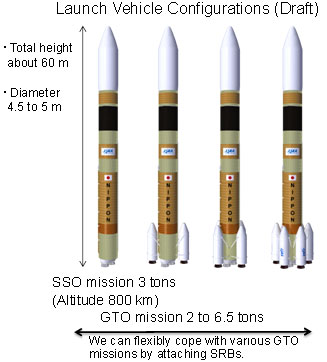JAXA Selection of Prime Contractor for Development and Launch Services of New National Flagship Launch Vehicle
The Japan Aerospace Exploration Agency (JAXA) made an announcement to the private sector on February 27, 2014, to compare their proposals and select a prime contractor who can be responsible for launch and space transportation services for a newly developed flagship launch vehicle. As a result, after carefully evaluated proposals including confirmation of application prerequisites and conformity with requirements, we have selected Mitsubishi Heavy Industries, Ltd. (MHI) as the prime contractor.
JAXA will begin developing the new national flagship launch vehicle in early Japan Fiscal Year 2014 in cooperation with a group of private companies led by MHI
For more information about the new flagship launch vehicle, please refer to the following.
Outline of the New Flagship Launch Vehicle
 [ Special features ]
[ Special features ]- The main liquid-engine core rockets will be the same specifications for all launch vehicles in the new series so that manufacturing and operation can be more efficiently performed.
- Up to six solid rocket boosters (depending on the needs) can be attached for a Geostationary Transfer Orbit (GTO) mission to be able to flexibly cope with diversified needs.
[ Development schedule ]
The development will begin in early Japan Fiscal Year 2014 targeting a maiden launch in JFY 2020.
[ Development details ]
- Launch vehicle development (structure, electronics/avionics, propulsion system, payload fairing)
- Engine development (for the first and second stages)
- Solid rocket booster development
- Launch pad, launch site ground facility development
Why do we need to develop a new flagship launch vehicle now?
As utilization of space is now imperative in various areas, such as using satellite data for our daily lives, it is important to secure the independent space transportation capability without relying on other countries to launch a satellite. Accordingly, the Japanese government also stipulates an autonomous space launch capacity as a basic space policy.The current flagship launch vehicle, H-IIA, is based on the conventional design concept of its predecessor, H-II, thus the H-IIA launch system applied many of the facilities built for the H-II. In other words, they are aging at over 30 years old since the H-II days, and they became so old that their maintenance costs are increasing year on year. In addition, no new launch vehicle development project has been conducted for about 15 years after the H-IIA development, hence skilled engineers who were involved in the actual development are graying. If we left this situation unattended, Japan will face difficulty to maintain our development and launch capability of launch vehicles in the future. Although our flagship launch vehicle technology is highly regarded, we need to lower the launch costs in order to procure commercial satellite launch demand from overseas in addition to our country's government satellites.. We have to renovate the overall launch system and develop a new flagship launch vehicle with high competitiveness for overcoming the above challenges and making it sustainable.
What kind of launch vehicle will that be?
We will apply a more sophisticated high-performance liquid hydrogen rocket engine that has been our specialty field to the first and second-stage engines while cutting its costs and improving its reliability. We will then attach solid rocket boosters that are based on our technology that has been fostered through the development of the Epsilon Launch Vehicle and so on. We can cope with a wide variety of launch needs by varying the number of solid rocket boosters to be attached. The basic structure of the new launch vehicle is similar to that of the H-IIA, but we will achieve two goals, low cost and high reliability, at the same time by introducing cutting-edge technologies in every area.How will be the responsibility sharing between JAXA and the private company?
JAXA will be in charge of managing and integrating the overall development of the new flagship launch vehicle by capitalizing on our knowledge acquired through our past launch vehicle development experiences, and constructing the best seamless system of the launch vehicle, ground facility and key technologies indispensable to autonomy. On the other hand, the private company (the prime contractor) will be uniformly responsible from development and launch services of the new launch vehicle in order to make it an internationally competitive rocket. JAXA will begin its development in cooperation with a group of private companies led by the prime contractor.Brief background
| May June 4, 2013: | Development of the new flagship launch vehicle was decided by the Japanese government (Notified by the Minister of National Space Policy to the other Cabinet Ministers concerned). |
| Jan. 15 (Fri.) thru 27 (Mon.), 2014: | Mission Definition Review (MDR) was held at JAXA. |
| Feb. 6 (Fri.) thru 17 (Mon.), 2014: | JAXA asked the private sector for the Request for Information (RFI) for the selection criteria of the prime contractor and the basic agreement (draft agreement.) |
| Feb. 21 (Fri.), 2014: | JAXA held a management review to confirm the readiness for the selection of the prime contractor and consequent start of development. |
| Feb. 27 (Thu.), 2014: | JAXA announced an invitation to the private sector on a proposal competition for the prime contractor for development and launch services of the new launch vehicles. |









